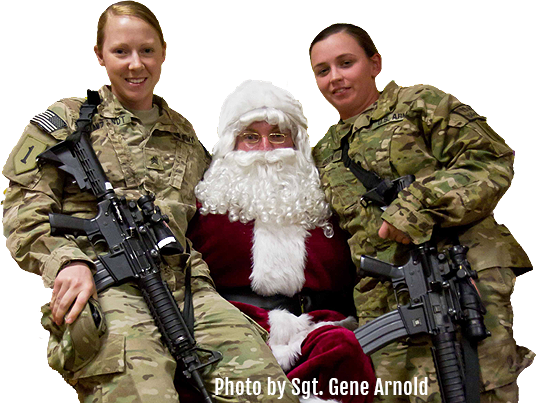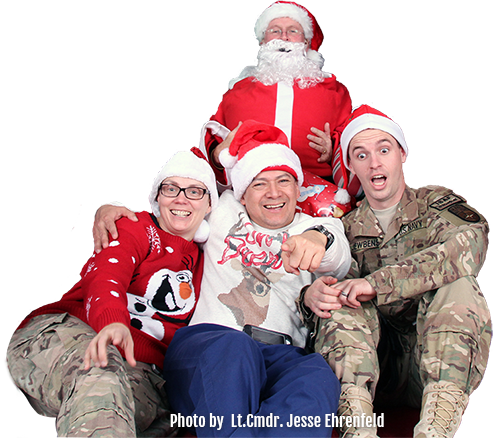Meet Your Military
- Details
- Hits: 3604
 Army Spc. Nathaniel Rockhill of the Indiana Army National Guard’s 38th Infantry Division prepares to compete during the 21st NATO Chess Championship in Koege, Denmark, Oct. 18, 2010. Rockhill placed 51st among more than 80 military members from around the world. Courtesy photo[/caption] INDIANAPOLIS – In the Army, infantry is known as the “Queen of Battle,â€Â and artillery is known as the “King of Battle.â€Â An Indiana National Guard soldier recently was able to command all the pieces and was not just a pawn in the game.
Army Spc. Nathaniel Rockhill of the Indiana Army National Guard’s 38th Infantry Division prepares to compete during the 21st NATO Chess Championship in Koege, Denmark, Oct. 18, 2010. Rockhill placed 51st among more than 80 military members from around the world. Courtesy photo[/caption] INDIANAPOLIS – In the Army, infantry is known as the “Queen of Battle,â€Â and artillery is known as the “King of Battle.â€Â An Indiana National Guard soldier recently was able to command all the pieces and was not just a pawn in the game.- Details
- Hits: 2333
[caption id="attachment_3215" align="alignleft" width="281"] Army Command Sgt. Maj. Jon Smith of the Indiana National Guard’s Recruiting and Retention Command presents Army Pfc. Alyssia Brown with a Minuteman statue in Indianapolis, Nov. 22, 2010. U.S. Army photo by Sgt. John Crosby[/caption]
Army Command Sgt. Maj. Jon Smith of the Indiana National Guard’s Recruiting and Retention Command presents Army Pfc. Alyssia Brown with a Minuteman statue in Indianapolis, Nov. 22, 2010. U.S. Army photo by Sgt. John Crosby[/caption]
 Army Pfc. Alyssia Brown of the Indiana National Guard receives the Army Commendation Medal and a Minuteman statue during a ceremony and banquet in Indianapolis, Nov. 22, 2010. Brown was recognized for her outstanding performance in basic combat training. U.S. Army photo by Sgt. John Crosby[/caption] While at MP school, Brown was recognized for her outstanding leadership skills for taking charge during a detail at the 2010 MP Warfighter Competition at Fort Leonard Wood. She was tasked with setting up tents for the competition. A group of people dressed in civilian attire asked for assistance in setting up a tent for their organization. Although she didn’t have to, Brown helped them. She quickly took charge, giving them guidance and expediting the process so she could return to her detail. As it turned out, the people she helped were high-ranking officials of the Criminal Investigation Command, and several weeks later she was recognized in front of her company for her efforts. Brown also was recognized as the distinguished honor graduate for her unwavering motivation, outstanding physical training scores and excellent rifle marksmanship. “I’m really glad to be honored like that, especially in front of my family on graduation,â€Â said Brown, whose mother recorded the ceremony. “They were all really proud of me. I’m just glad that I was able to work hard enough to get to be able to go up on stage and have my name called off. If even to be recognized just for a fraction of a second, it was truly an honor.â€Â Now that she has graduated, Brown will return to her roots at the RSP for one last drill before moving onto her permanent unit. “It has been a great pleasure having her as a RSP soldier; she really sets the standard as to what we want all of our soldiers to be like,â€Â said Army Staff Sgt. David Grimm, training sergeant for the recruit program’s Detachment 2 in Fort Wayne, Ind. “When I first met her, she was very respectful and eager to learn and grow as a soldier. She always has a great attitude and demeanor, and that ‘never-say-quit’ attitude always rubbed off on others.â€Â Grimm added that he believes the leadership qualities Brown has displayed and her experience to become an MP will carry on when she returns to the RSP. “She has a great relationship with her fellow soldiers,â€Â he said. “She goes out of her way to help others with anything they may be doing at the time. She takes pride in being a battle buddy and a friend, and she shows all of the leadership qualities a young soldier could possess.â€Â Brown’s family has embraced her role as a soldier and takes pride in her achievements. “I couldn’t be more proud of her,â€Â said Jeff Brown, the soldier’s father. “I’ve always encouraged her and her brother to join. I couldn’t be more proud of them both. “I think there might be a bit of a rivalry growing between her and her brother now,â€Â he continued. “He didn’t take home all those plaques and medals that she did.â€Â His daughter’s enlistment has strengthened their bond, he said, and has given them something else in common: law enforcement. “Alyssia and I will sit and talk about law, what she can and can’t do as a soldier, what I can and can’t do as a civilian,â€Â he said. “She’s really grown into it.â€Â Brown said she plans to maintain her professionalism and always remember the promise she made to her country, her mother and to herself. “It’s been a life-changing experience for me,â€Â she said. “There’s a responsibility that you put on yourself that you can’t put on anybody else that pushes you to your limits and shows you that you can still succeed.â€Â Nov. 26, 2010: By Army Sgt. John Crosby- Indiana National Guard
Army Pfc. Alyssia Brown of the Indiana National Guard receives the Army Commendation Medal and a Minuteman statue during a ceremony and banquet in Indianapolis, Nov. 22, 2010. Brown was recognized for her outstanding performance in basic combat training. U.S. Army photo by Sgt. John Crosby[/caption] While at MP school, Brown was recognized for her outstanding leadership skills for taking charge during a detail at the 2010 MP Warfighter Competition at Fort Leonard Wood. She was tasked with setting up tents for the competition. A group of people dressed in civilian attire asked for assistance in setting up a tent for their organization. Although she didn’t have to, Brown helped them. She quickly took charge, giving them guidance and expediting the process so she could return to her detail. As it turned out, the people she helped were high-ranking officials of the Criminal Investigation Command, and several weeks later she was recognized in front of her company for her efforts. Brown also was recognized as the distinguished honor graduate for her unwavering motivation, outstanding physical training scores and excellent rifle marksmanship. “I’m really glad to be honored like that, especially in front of my family on graduation,â€Â said Brown, whose mother recorded the ceremony. “They were all really proud of me. I’m just glad that I was able to work hard enough to get to be able to go up on stage and have my name called off. If even to be recognized just for a fraction of a second, it was truly an honor.â€Â Now that she has graduated, Brown will return to her roots at the RSP for one last drill before moving onto her permanent unit. “It has been a great pleasure having her as a RSP soldier; she really sets the standard as to what we want all of our soldiers to be like,â€Â said Army Staff Sgt. David Grimm, training sergeant for the recruit program’s Detachment 2 in Fort Wayne, Ind. “When I first met her, she was very respectful and eager to learn and grow as a soldier. She always has a great attitude and demeanor, and that ‘never-say-quit’ attitude always rubbed off on others.â€Â Grimm added that he believes the leadership qualities Brown has displayed and her experience to become an MP will carry on when she returns to the RSP. “She has a great relationship with her fellow soldiers,â€Â he said. “She goes out of her way to help others with anything they may be doing at the time. She takes pride in being a battle buddy and a friend, and she shows all of the leadership qualities a young soldier could possess.â€Â Brown’s family has embraced her role as a soldier and takes pride in her achievements. “I couldn’t be more proud of her,â€Â said Jeff Brown, the soldier’s father. “I’ve always encouraged her and her brother to join. I couldn’t be more proud of them both. “I think there might be a bit of a rivalry growing between her and her brother now,â€Â he continued. “He didn’t take home all those plaques and medals that she did.â€Â His daughter’s enlistment has strengthened their bond, he said, and has given them something else in common: law enforcement. “Alyssia and I will sit and talk about law, what she can and can’t do as a soldier, what I can and can’t do as a civilian,â€Â he said. “She’s really grown into it.â€Â Brown said she plans to maintain her professionalism and always remember the promise she made to her country, her mother and to herself. “It’s been a life-changing experience for me,â€Â she said. “There’s a responsibility that you put on yourself that you can’t put on anybody else that pushes you to your limits and shows you that you can still succeed.â€Â Nov. 26, 2010: By Army Sgt. John Crosby- Indiana National Guard- Details
- Hits: 2254
[caption id="attachment_4392" align="alignleft" width="276"] Army Col. John Ward, division operations officer, 1st Armored Division, United States Division – Center, inducts Staff Sgt. Jason Motes into the Order of St. George during a ceremony in Baghdad, Nov. 15, 2010. U.S. Army photo by Sgt. Kimberly Johnson[/caption] BAGHDAD – Army Staff Sgt. Jason Motes is now among an elite brotherhood within the United States Armor Association -- The Order of St. George, symbolizing bravery, dedication and decency. Motes, the future operations noncommissioned officer-in-charge with Company A, Division Special Troops Battalion, 1st Armored Division, United States Division –- Center, is one of very few staff sergeants who have been inducted into the order. “The Order of St. George, to me, is the tradition for [tank crewmen],â€Â said Motes, a Delaware, Ohio, native. “It symbolizes one’s long effort toward [excellence in] our branch. It’s a big honor.â€Â According to the U.S. Armor Association, the history of St. George dates back to about 280 A.D. St. George was a member of the Roman emperor’s mounted guard and was imprisoned, tortured and executed for standing up against the emperor, refusing an order to destroy all Christian churches and sacred writings. More than 1,000 years later, citizens of a small Italian village claim that St. George appeared and killed a dragon that was tormenting the town. It is that historic image of St. George that symbolizes the heroism and bravery of mounted warriors. Over the years, soldiers of several nations have given accounts of St. George appearing on battlefields to aid in their victories. St. George is the only saint portrayed as fighting mounted, and in 1986 the U.S. Armor Association established the order to recognize the best tankers and cavalrymen in the Army. “If anyone of the junior level of leadership deserves the Order of St. George, it is Staff Sgt. Motes,â€Â said Sgt. Maj. Dale Sump, the division master gunner with A Company, DSTB, and a Cherokee, Iowa, native. “Just because of the way he attacks a problem and how adaptable he is … that’s really what the Army needs right now.â€Â Sump, who nominated Motes for the honor, said the Order of St. George medallion is a new medal for staff sergeants. He said there were previously just three levels of the medallion -- bronze, silver and gold -- given only to senior enlisted soldiers and officers. During Operation Iraqi Freedom, Sump said, the Army established a new black medallion to recognize junior exceptional armor leaders. Motes’ family has a tradition of soldiering; his brother and father are both infantrymen. He said he wanted something different and chose the armor branch. “It’s a brotherhood,â€Â Motes said. “I am now a part of a very few people who have [been inducted into] the Order of St. George. Being knighted during the ceremony is a sign of respect for what I’ve done, what I could do, and what my leaders think I can do more of.â€Â Nov. 24, 2010: By Army Sgt. Kimberly Johnson- 1st Armored Division
Army Col. John Ward, division operations officer, 1st Armored Division, United States Division – Center, inducts Staff Sgt. Jason Motes into the Order of St. George during a ceremony in Baghdad, Nov. 15, 2010. U.S. Army photo by Sgt. Kimberly Johnson[/caption] BAGHDAD – Army Staff Sgt. Jason Motes is now among an elite brotherhood within the United States Armor Association -- The Order of St. George, symbolizing bravery, dedication and decency. Motes, the future operations noncommissioned officer-in-charge with Company A, Division Special Troops Battalion, 1st Armored Division, United States Division –- Center, is one of very few staff sergeants who have been inducted into the order. “The Order of St. George, to me, is the tradition for [tank crewmen],â€Â said Motes, a Delaware, Ohio, native. “It symbolizes one’s long effort toward [excellence in] our branch. It’s a big honor.â€Â According to the U.S. Armor Association, the history of St. George dates back to about 280 A.D. St. George was a member of the Roman emperor’s mounted guard and was imprisoned, tortured and executed for standing up against the emperor, refusing an order to destroy all Christian churches and sacred writings. More than 1,000 years later, citizens of a small Italian village claim that St. George appeared and killed a dragon that was tormenting the town. It is that historic image of St. George that symbolizes the heroism and bravery of mounted warriors. Over the years, soldiers of several nations have given accounts of St. George appearing on battlefields to aid in their victories. St. George is the only saint portrayed as fighting mounted, and in 1986 the U.S. Armor Association established the order to recognize the best tankers and cavalrymen in the Army. “If anyone of the junior level of leadership deserves the Order of St. George, it is Staff Sgt. Motes,â€Â said Sgt. Maj. Dale Sump, the division master gunner with A Company, DSTB, and a Cherokee, Iowa, native. “Just because of the way he attacks a problem and how adaptable he is … that’s really what the Army needs right now.â€Â Sump, who nominated Motes for the honor, said the Order of St. George medallion is a new medal for staff sergeants. He said there were previously just three levels of the medallion -- bronze, silver and gold -- given only to senior enlisted soldiers and officers. During Operation Iraqi Freedom, Sump said, the Army established a new black medallion to recognize junior exceptional armor leaders. Motes’ family has a tradition of soldiering; his brother and father are both infantrymen. He said he wanted something different and chose the armor branch. “It’s a brotherhood,â€Â Motes said. “I am now a part of a very few people who have [been inducted into] the Order of St. George. Being knighted during the ceremony is a sign of respect for what I’ve done, what I could do, and what my leaders think I can do more of.â€Â Nov. 24, 2010: By Army Sgt. Kimberly Johnson- 1st Armored Division
- Details
- Hits: 3318
 Air Force Capt. Rob Marshall prepares to ski down from the summit of Mt. Elbrus, the highest peak in Russia, with fellow airman and mountaineer Capt. Mark Uberuaga, now with the 55th Rescue Squadron, Davis-Monthan Air Force Base, N.M., after completing their first climb as part of the U.S. Air Force Seven Summits Challenge in July 2005. The challenge is an endeavor for Air Force members to carry the Air Force flag to the highest point on each continent and to be the first U.S. military group to conquer all seven peaks. Marshall is a member of the 8th Special Operations Squadron at Hurlburt Field, Fla. Courtesy photo[/caption] HURLBURT FIELD, Fla. – Two Air Force captains have set their sights to conquer Antarctica’s highest mountain.
Air Force Capt. Rob Marshall prepares to ski down from the summit of Mt. Elbrus, the highest peak in Russia, with fellow airman and mountaineer Capt. Mark Uberuaga, now with the 55th Rescue Squadron, Davis-Monthan Air Force Base, N.M., after completing their first climb as part of the U.S. Air Force Seven Summits Challenge in July 2005. The challenge is an endeavor for Air Force members to carry the Air Force flag to the highest point on each continent and to be the first U.S. military group to conquer all seven peaks. Marshall is a member of the 8th Special Operations Squadron at Hurlburt Field, Fla. Courtesy photo[/caption] HURLBURT FIELD, Fla. – Two Air Force captains have set their sights to conquer Antarctica’s highest mountain.- Details
- Hits: 5130
 MARINE CORPS AIR GROUND COMBAT CENTER, TWENTYNINE PALMS, Calif. – Afghan soldiers are in for a surprise when they meet their new instructor, Marine Corps Staff Sgt. Tricia McBride, the first female Marine assigned to advise host-nation forces in Afghanistan.
MARINE CORPS AIR GROUND COMBAT CENTER, TWENTYNINE PALMS, Calif. – Afghan soldiers are in for a surprise when they meet their new instructor, Marine Corps Staff Sgt. Tricia McBride, the first female Marine assigned to advise host-nation forces in Afghanistan.






